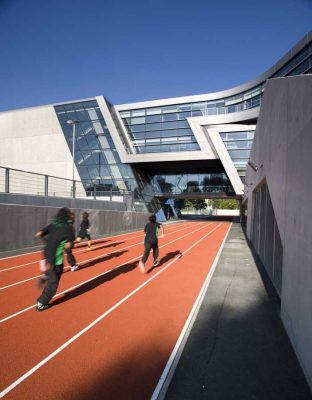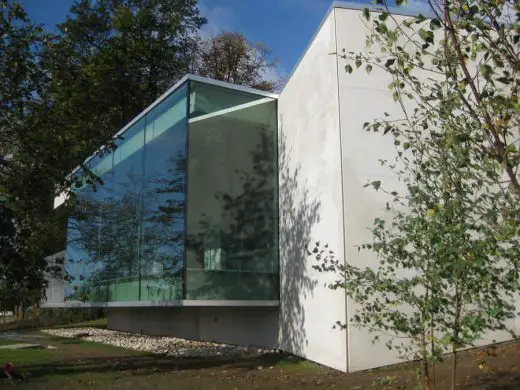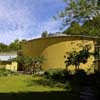Long Life, Loose Fit, Low Energy, Architecture Comment, Building Design, Architects News
Persistence of the Absurd: Stirling Prize Analysis 2011
The Future of Architecture – article for e-architect by Professor Gordon Murray
11 Oct 2011
Stirling Prize Criticism
The Persistence of the Absurd
By Professor Gordon Murray
Newsletter article #125

image of Professor Gordon Murray
In 1971 Alex Gordon became President of RIBA with the mantra; Long Life, Loose Fit, Low Energy. As a mission statement LL:LF:LE has never been bettered and certainly not by any subsequent RIBA policy document. The idea of building for permanence–optimising materials performance, yet being flexible enough to accommodate change and adaptability over a lifetime, whilst minimising energy consumption is surely the ultimate holistic objective for any architecture. Why then has such a desirable situation taken forty years to even approach fruition in the wider built environment?
After hearing the news of this year’s Stirling Prize winner I went to Reyner Banham’s essay ‘Vehicles of Desire’ from 1955. There Banham identifies a particular problem, the central problem, in my view: “Far from being uomini-universali architects are by training, aesthetics and psychological predisposition, narrowly committed to the design of big permanent single structures and their efforts are directed merely to focusing big permanent human values as unrepeatable works of art.”
In the ensuing period architects appear to have taken this to a state-of-the-art condition. Whilst physics and gravity ensure that some form of logical restraint is applied, the drift toward confirming Banham’s view is apparently unstoppable. With digital technology permitting a direct translation from CAD image to built reality all (or most) is possible. Yet just because we can do it doesn’t mean we should. In reviewing some of the most recent newly published architecture from around the world I am reminded of the styling wars of 1950s Detroit car manufacturers. Bigger tail-fins, more chrome. Banham goes further in his essay: “a good job of body styling should come across like a good musical – no fussing after big, timeless abstract virtues but maximum glitter and maximum impact.”
In 2005 in his introduction to The making of the Stirling Prize – Ten Years of Architecture and Invention, Tony Chapman cites architecture as “less elitist than other (art) forms because it is not just an art form; it is a practical art. We could not live without the work of architects”.
Stirling Prize Winner – Evelyn Grace Academy, London:

picture : Luke Hayes
It is interesting to note that in the public vote on this year’s Stirling Prize over 90% of the votes cast were for two buildings: the Olympic Velodrome and an arts building in a gap site in Derry – significant as Derry moves to become European City of Culture in 2013. The other four gaining just 10% suggests with clarity just how as a nation we appear at ease living without the work of architects or a least being aware of it.
As the history of most countries informs us, to build is a political act, architecture is very much in the political arena. It may be a practical art as Tony Chapman suggests but it is also viewed with envy, suspicion and duplicity by those standing on the outside. Fact and figures from a closed language used for specific ends. How can we separate the achievements of a piece of architecture from the budget provided for its creation and for the potential leverage possible by utilising this budget for wider gain in place-making or community transformation. Both essential but difficult in measurement. Yet the restorative impact of well-designed environment on heath, well-being and knowledge enhancement is both self-evident and well researched. More difficult is assessing the cultural benefits achieved by the architect in reasserting existing values or in shifting them positively to some new territory.
In the same way that I recall the furore in the Museum of Scotland on the evening the Stirling Prize was presented to EMBT/RMJM for the Scottish Parliament, due to its “apparently profligate” budget; I suspect similar allegations towards this year’s winner as it strays into politically acute territory. Particularly, in a year when such prevalent attitudes in the school buildings programme required serious rebuttal at Government level. The jury is still out on whether or not this has been successfully achieved. Yet I was bemused that the Principal of Evelyn Grace Academy gave an affirmative answer to the question…”could you build such a visually exciting building more cheaply?” If the answer is yes then why not do it!
Maggie’s Gartnavel, Glasgow, Scotland
OMA – world exclusive

photograph © Adrian Welch
In the week when Rem Koolhaas opened OMA’s Maggie’s building at Gartnavel in the west end of Glasgow, it is worth recalling that Richard Murphy’s Maggie’s Centre in Edinburgh was shortlisted for the Stirling Prize in 1997, one of a number of more modest achievements that in those days regularly found a placing. It is in those more modest achievements that for me the real architecture to be found; in the RIBA Long List: Sarah Wigglesworth’s Sandal Magna School in Sheffield and David Lea’s Wise Building for CAT to name two, that I suspect are closer to the LL, LF, LE objective than many.
Sandal Magna Community Primary School, Wakefield
Sarah Wigglesworth Architects

photo : Mark Hadden Photography
WISE Building Machynlleth
David Lea and Pat Borer Architects

photo © Tim Soar
If architecture really is a public art, an essential part of our everyday lives and if architects mean to be taken seriously, and at a level that convinces all – public and politician alike – of their relevance then we are going to need to be a lot smarter and innovative than to continue to replicate the long outdated architectural values apparent in this year’s RIBA Prizewinners. A lot more effort needs to go into ensuring that practices, often young, smaller, intellectually agile outfits, who are already working and innovating in such an environment are given airtime.
Which brings me back to Banham, and Vehicles of Desire….“the next time an open Caddy wambles past you, its front chrome-hung, like a pearl roped dowager, its long top level with the ground at a steady thirty inches, save where two tail fins cock up to carry the rear lights, reflect……….”
Professor Gordon Murray B.Sc. B.Arch. PPRIAS RIBA RIAI RTPI MCIArb
Director – Knowledge Exchange
Department of Architecture
University of Strathclyde
Uni: 0141 548 3014
GMA: 0141 331 2926
M:07977 449 572
This week’s editor is Gordon Murray
GORDON MURRAY
Principal
B.Sc., B.Arch., P.P.R.I.A.S., R.I.B.A., R.I.A.I., R.T.P.I., M.C.I. Arb.
gordonm@gordonmurrayarchitects.com
Gordon Murray is principal of the newly formed Gordon Murray Architects, having practiced in Glasgow for thirty years. Since becoming a partner in Cunningham Glass Architects in 1988 he has adapted and developed the practice, from 2000-2010 as gm+ad architects. The practice has long been recognised, both within Scotland and internationally, for projects which are thoughtful and thought provoking.
“Reduced to the maximum” is a personal mission statement. His work has been exhibited at the Royal Institute of British Architects in London, at the Royal Scottish Academy and RIAS in Edinburgh, the Lighthouse in Glasgow; and in Rotterdam and Marseilles- as well as in the 2004 Venice Biennale. As a commentator on architecture in Scotland, he has written for The Herald, Scotsman and various architectural publications including Architects Journal, Architectural Review, ARQ and Prospect; and broadcast on radio and television. He was joint author of the monograph James Miller: Architect. He was awarded the Royal Scottish Academy medal in 1990.
In 2004 he was appointed External Examiner at the University of Ulster School of Architecture in Belfast. He was appointed Professor of Architecture and Urban Design, and Head of School at the University of Strathclyde in 2007.
He has over the last ten years occasionally taught in Schools of Architecture in Glasgow, Edinburgh, Cardiff, Belfast and at the Bauhaus in Dessau, Berlin.
In 2008 he participated in a conference and workshop in Auckland, New Zealand on behalf of Scottish Government and OECD in Paris on Inclusion and Integration through Innovation- the uses of design in education buildings to enhance inclusion.
He was President of The Royal Incorporation of Architects in Scotland 2003-5 and a Trustee of the Lighthouse-Scotland’s National Centre for Architecture, Design and the City from 2003-09. A member of the Board of Architects Professional Examination Authority Scotland, he was also recently elected Chair of SCHOSA – 2010/12 – The committee of Heads of Schools of Architecture across UK.
Comments on this Persistence of the Absurd article by Gordon Murray Architect, Glasgow, are welcome.
International Architectural Designs
Other Designs shown on e-architect:
Novancia business school, Paris, France
Architecture-Studio

photograph : Georges Fessy
Elbphilharmonie concert hall, Hamburg, Germany
Herzog and de Meuron – new photos
The Shard photos – exclusive to e-architect
Design: Renzo Piano Building Workshop (RPBW)
World Architecture Festival Awards Shortlist 2011
Comments re Stirling Prize Opinion – Architecture Award Criticism welcome





